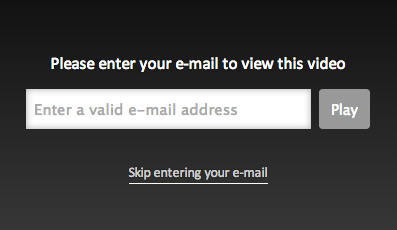How To Use Video Content To Generate, Qualify And Score Leads
Video might require an investment, says columnist Michael Litt, but it can give you key insights into your audience, which will ultimately lead to more sales.

As much as we’d like to create videos just to entertain people and make them laugh, at some point, your boss is going to ask what your videos are doing to help the company. You do work in the marketing department, after all, and your sales team has an insatiable appetite for leads.
Fortunately, you shouldn’t have to search too hard for an answer because video offers amazing opportunities to engage audiences and generate new and better leads. The data you can collect about how each individual person watches your videos will help you prioritize your follow-up.
For example, you will know that “Jill Smith” watched your entire product explanation video and then went on to watch a two-minute “how-to” video. Meanwhile, “Bill Jones” only watched 10 seconds of an explainer video and turned it off. Which one are you going to recommend the sales team call first? (Hint: That’s not a trick question.)
Obviously, Jill is going to be more interested in taking a call from a sales rep than Bill is. That data is extremely powerful, and it’s information that you can’t get from text-based content or even from the videos you post on YouTube or with a traditional video hosting platform.
You might be able to see that Jill and Bill both downloaded that two-page case study from your website, but you have no idea whether they read it or just left it to sit behind 12 other tabs on their laptop.
Identify Your Leads: Set Up An Email Gate
So how do you identify Jill and Bill in the first place to identify them as leads? The simplest way to gather prospects’ contact information is to set up an email gate at the beginning of the video.
Asking viewers to enter their email address before gaining access to a video allows you to create a new lead as soon as a prospect expresses interest. It might look like this:

This lead capture method is best suited to mid-funnel videos because the buyer has already demonstrated some interest in what you have to offer. Asking for an email address on a video at the top of the funnel might turn someone off. However, if you put the gate on a mid-funnel video, it automatically becomes a qualifier.
For example, if you have a trail of content leading to a detailed product demo, you could gate the demo to see how many viewers will volunteer their information having already received quality ungated content beforehand. If you’ve piqued their interest with good top-of-funnel content in advance, you’ll score high-quality leads because they’ll have watched a few videos before the mid-funnel email gate.
Keeping track of every lead’s video-viewing history can be a lot of work, but integrating your video marketing platform with your marketing automation platform or CRM (customer relationship management) makes it much easier.
That’s how you make it actionable and see the video data in the context of all the other touch points you’ve had with a particular person. That’s how you’ll know that in addition to watching multiple videos to completion, Jill Smith also attended a recent webinar and downloaded your white paper on how to use video for lead generation.
Don’t Fade To Black: Think About The Next Step
Which brings me to my next point. One of the first rules of video marketing is not to let your video fade to black at the end. If viewer have made it all the way to the end, give them some direction on where to go next. Make it easy to share what they just watched. Refer them to another video. Point them to a related case study.
Just think about the customer’s journey and send them to an appropriate next step. For example, if someone just watched your homepage high-level explainer video, don’t send them to a super-specific technical how-to video. Instead, perhaps you give them a series of short product tours that lead to a white paper download or information about setting up a free trial.
Of course, engagement goes beyond the calls-to-action at the end of a video. Once you know you have engaged prospects, take a look at their viewing data to see what they’ve watched. That will help you determine how to follow up appropriately.
For example, if Jill Smith watched several videos about your products, you can automate a nurture email to be delivered immediately after she watched a particular video. Talk about striking while the iron is hot!
This kind of data is powerful for both marketers and salespeople — knowing which videos your prospects have watched allows your salespeople to form more meaningful conversations and go into calls armed with the info they need to close more deals.
Video = Powerful Data
Using a video marketing platform allows you make data actionable and pull video into your data-driven marketing strategy. When you add video to your lead scoring rules, you’ve now added another qualification channel to your funnel, and you’ll be moving leads to your sales team even faster.
When it comes to lead scoring, the rich video engagement data enables some pretty sophisticated opportunities. You might set a score when someone clicks play on a video and add to it if they complete it. You might assign a multiplier based on the type of video, giving more weight to a product explainer than a basic introduction video.
You can also take into account the period of time in which the videos were watched. If Jill Smith watched all of her videos within a 48-hour period, she’s likely more interested than if she watched them over six months.
As I’ve noted previously, video requires an investment, but unlike every other form of content you’re investing in, video will come with data that tells you whether it’s working. If you only score a prospect based on e-book downloads or email views, you may be missing out on other hints they’ve been dropping you.
Video gives you more insight into those hints. More insight means more detailed qualifications, which makes for much warmer sales calls.
I don’t know how things work at your company, but at mine, warmer sales calls lead to more sales, which leads to a happy sales team and ultimately a happy boss.
Contributing authors are invited to create content for MarTech and are chosen for their expertise and contribution to the martech community. Our contributors work under the oversight of the editorial staff and contributions are checked for quality and relevance to our readers. MarTech is owned by Semrush. Contributor was not asked to make any direct or indirect mentions of Semrush. The opinions they express are their own.
Related stories